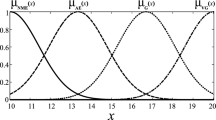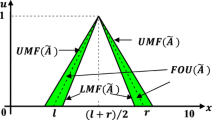Abstract
It is obvious that education institutions must provide students with the evaluation reports regarding their test/examination as sufficient as possible and with the unavoidable error as small as possible. In this paper, we present a new method for evaluating students’ answerscripts using vague values, where the evaluating marks awarded to the questions in the students’ answerscripts are represented by vague values. The vague mark awarded to each question of a student’s answerscript can be regarded as a vague set, where each element in the universe of discourse belonging to the vague set is represented by a vague value. An index of optimism λ determined by the evaluator is used to indicate the degree of optimism of the evaluator, where λ∈[0,1]. The larger the value of λ, the more optimistic the evaluator. The smaller the value of λ, the more pessimistic the evaluator. The proposed method can evaluate students’ answerscripts in a more flexible and more intelligent manner.
Similar content being viewed by others
References
Altun A, Cakan M (2006) Undergraduate students’ academic achievement, field dependent/independent cognitive styles and attitude toward computers. Educ Technol Soc 9(1):289–297
Biswas R (1995) An application of fuzzy sets in students’ evaluation. Fuzzy Sets Syst 74(2):187–194
Chang DF, Sun CM (1993) Fuzzy assessment of learning performance of junior high school students. In: Proceedings of the 1993 first national symposium on fuzzy theory and applications, Hsinchu, Taiwan, Republic of China, pp 10-15
Chen SM (1995) Arithmetic operations between vague sets. In: Proceedings of the international joint conference of CFSA/IFIS/SOFT’95 on fuzzy theory and applications, Taipei, Taiwan, Republic of China, pp 206–211
Chen SM (1988) A new approach to handling fuzzy decision making problems. IEEE Trans Syst Man Cybern 18(6):1012–1016
Chen SM, Yeh MS, Hsiao PY (1995) A comparison of similarity measures of fuzzy values. Fuzzy Sets Syst 72(1):79–89
Chen SM (1995) Measures of similarity between vague sets. Fuzzy Sets Syst 74(2):217–223
Chen SM (1997) Similarity measures between vague sets and between elements. IEEE Trans Syst Man Cybern Part B: Cybern 27(1):153–158
Chen SM (1999) Evaluating the rate of aggregative risk in software development using fuzzy set theory. Cybern Syst 30(1):57–75
Chen SM, Lee CH (1999) New methods for students’ evaluation using fuzzy sets. Fuzzy Sets Syst 104(2):209–218
Chen SM, Wang JY (1995) Document retrieval using knowledge-based fuzzy information retrieval techniques. IEEE Trans Syst Man Cybern 25(5):793–803
Cheng CH, Yang KL (1998) Using fuzzy sets in education grading system. J Chin Fuzzy Syst Assoc 4(2):81–89
Chiang TT, Lin CM (1994) Application of fuzzy theory to teaching assessment. In: Proceedings of the 1994 second national conference on fuzzy theory and applications, Taipei, Taiwan, Republic of China, pp 92–97
Devedzic V (2004) Web intelligence and artificial intelligence in education. Educ Technol Soc 7(4):29–39
Echauz JR, Vachtsevanos GJ (1995) Fuzzy grading system. IEEE Trans Educ 38(2):158–165
Frair L (1995) Student peer evaluations using the analytic hierarchy process method. In: Proceedings of 1995 frontiers in education conference, vol 2, pp 4c3.1–4c3.5
Gau WL, Buehrer DJ (1993) Vague sets. IEEE Trans Syst Man Cybern 23(2):610–614
Kaburlasos VG, Marinagi CC, Tsoukalas VT (2004) PARES: a software tool for computer-based testing and evaluation used in the Greek higher education system. In: Proceedings of the 2004 IEEE international conference on advanced learning technologies, pp 771–773
Law CK (1996) Using fuzzy numbers in education grading system. Fuzzy Sets Syst 83(3):311–323
Ma J, Zhou D (2000) Fuzzy set approach to the assessment of student-centered learning. IEEE Trans Educ 43(2):237–241
McMartin F, Mckenna A, Youssefi K (2000) Scenario assignments as assessment tools for undergraduate engineering education. IEEE Trans Educ 43(2):111–119
Pears A, Daniels M, Berglund A, Erickson C (2001) Student evaluation in an international collaborative project course. In: Proceedings of the 2001 symposium on applications and the Internet workshops, pp 74–79
Rasmani KA, Shen Q (2006) Data-driven fuzzy rule generation and its application for student academic performance evaluation. Appl Intell 25(3):305–319
Wang HY, Chen SM (2006) New methods for evaluating students’ answerscripts using vague values. In: Proceedings of the 9th joint conference on information sciences, Kaohsiung, Taiwan, Republic of China, pp 1184–1187
Weon S, Kim J (2001) Learning achievement evaluation strategy using fuzzy membership function. In: Proceedings of the 31st ASEE/IEEE frontier in education conference, Reno, NV, pp T3A-19–T3A-24
Wilson E, Karr CL, Freeman LM (1998) Flexible, adaptive, automatic fuzzy-based grade assigning system. In: Proceedings of the 1998 North American fuzzy information processing society (NAFIPS) conference, pp 334–338
Wu MH (2003) A research on applying fuzzy set theory and item response theory to evaluate learning performance. Master thesis, Department of Information Management, Chaoyang University of Technology, Wufeng, Taichung County, Republic of China
Zadeh LA (1965) Fuzzy sets. Inf Control 8:338–353
Author information
Authors and Affiliations
Corresponding author
Rights and permissions
About this article
Cite this article
Wang, HY., Chen, SM. Evaluating students’ answerscripts using vague values. Appl Intell 28, 183–193 (2008). https://doi.org/10.1007/s10489-007-0060-4
Received:
Accepted:
Published:
Issue Date:
DOI: https://doi.org/10.1007/s10489-007-0060-4




